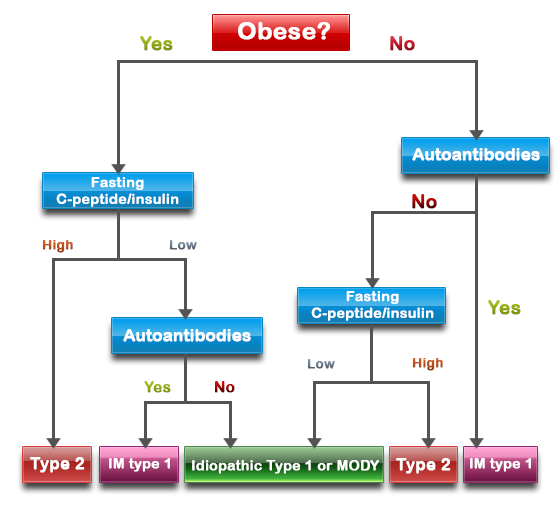It is not always obvious which type of diabetes someone may have and it may be necessary for your health to carry out specific tests to find out which type of diabetes you have.
In some cases, people initially diagnosed with one type of diabetes may be given a re-diagnosis at a later date.
Which types of diabetes exist?
- Type 1 diabetes – an autoimmune disease, often, but not always, diagnosed in children
- Type 2 diabetes – characterised by the body not responding properly to insulin, often, but not always, associated with having excess body weight
- Gestational diabetes – a form of diabetes, similar to type 2 diabetes, that specifically develops during pregnancy
- Prediabetes – an early form of type 2 diabetes
- LADA – a slower progressing form of type 1 diabetes that can develop in adults
- MODY – a form of diabetes caused by specific genetic mutations
There is a distinct difference between type 1 and type 2 diabetes, although it may not be evident without the correct tests. Find out more about the differences between type 1 and type 2 diabetes
Tests to diagnose different types of diabetes
If your health team are in doubt about which type of diabetes you have, you may need to have one or more tests to deduce which type of diabetes you have.
The following flowchart shows how tests can be carried out to distinguish between different types of diabetes.

Explanation of the flowchart:
- C-peptide : A C-peptide test is used to assess how much insulin your pancreas is producing
- Autoantibodies: Autoantibodies refers to immune cells which target and kill the insulin producing cells in the pancreas, a GAD test is used to detect the presence of specific autoantibodies in the blood
- Type 2 : Type 2 diabetes – most common in adults
- IM Type 1 : Immune mediated type 1 diabetes, the most common form of type 1 diabetes
- Idiopathic Type 1: A rare form of type 1 diabetes with no known cause
- MODY : Maturity onset diabetes of the young, a rarer form of diabetes caused by specific genetic mutations
When might these tests be needed?
Specific tests, such as for c-peptide levels or autoantibodies, may be needed in the following example cases:
- Diabetes is diagnosed in a slightly overweight 40 year old with normal blood pressure and cholesterol levels
- Recently diagnosed diabetes in a 60 year old with a healthy weight with tablets having little effect in lowering blood glucose levels
Have I been diagnosed correctly?
Occasionally, people may have their initial diagnosis altered. For example, someone initially diagnosed with type 2 diabetes may be told they actually have a form of type 1 diabetes.
In the UK, it is not standard practice to carry out tests to specifically diagnose which type of diabetes you have but it may be required if, for example, your blood glucose levels are not responding well to tablet medications.
Does it matter which type of diabetes I’m diagnosed with?
The most important aspect of getting the right diagnosis is in ensuring you’re on an appropriate medication regimen to adequately control your diabetes
I’ve been put on insulin, do I now have type 1 diabetes?
There is no straight answer that can be given without consulting your doctor.
It is relatively common for people with confirmed type 2 diabetes to move onto insulin injections.
However, in some cases, people diagnosed initially with type 2 diabetes may be re-diagnosed by their doctors as having a form of type 1 diabetes
There can sometimes be grey areas and in some cases specific diagnostic tests may be required to confirm which type of diabetes you have.
Why isn’t LADA listed?
LADA is a slower progressing form of type 1 diabetes that occurs in adults. For simplicity, the flowchart does not attempt to differentiate between LADA and juvenile forms of type 1 diabetes.
Which type of diabetes is worse?
This question is often asked in the Diabetes Forum Ultimately, neither is ‘worse’ as each person is unique and diabetes affects people in different ways.
- People with type 1 diabetes need insulin, whereas people with type 2 diabetes may require large amounts of insulin due to being resistant to insulin
- People with type 1 diabetes often get diagnosed earlier and quicker as type 1 diabetes is often spotted in childhood
- People with type 2 diabetes can often be undiagnosed for lengthy periods of time



